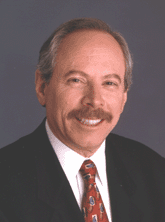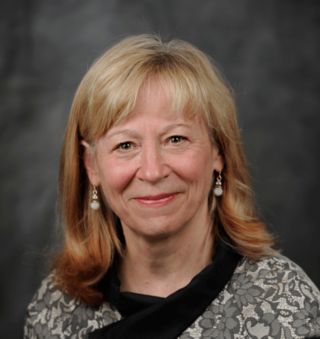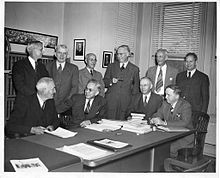
David Jonathan Gross is an American theoretical physicist and string theorist. Along with Frank Wilczek and David Politzer, he was awarded the 2004 Nobel Prize in Physics for their discovery of asymptotic freedom. Gross is the Chancellor's Chair Professor of Theoretical Physics at the Kavli Institute for Theoretical Physics (KITP) of the University of California, Santa Barbara (UCSB), and was formerly the KITP director and holder of their Frederick W. Gluck Chair in Theoretical Physics. He is also a faculty member in the UCSB Physics Department and is affiliated with the Institute for Quantum Studies at Chapman University in California. He is a foreign member of the Chinese Academy of Sciences.

The American Meteorological Society (AMS) is a scientific and professional organization in the United States promoting and disseminating information about the atmospheric, oceanic, and hydrologic sciences. Its mission is to advance the atmospheric and related sciences, technologies, applications, and services for the benefit of society.

Armand Paul Alivisatos is a Greek-American etymologist, chemist and academic administrator who has served as the 14th president of the University of Chicago since September 2021. He is a pioneer in nanomaterials development and an authority on the fabrication of nanocrystals and their use in biomedical and renewable energy applications. He was ranked fifth among the world's top 100 chemists for the period 2000–2010 in the list released by Thomson Reuters.

Fellowship of the American Association for the Advancement of Science (FAAAS) is an honor accorded by the American Association for the Advancement of Science (AAAS) to distinguished persons who are members of the Association. Fellows are elected annually by the AAAS Council for "efforts on behalf of the advancement of science or its applications [which] are scientifically or socially distinguished".

Lisa Feldman Barrett is a Canadian-American psychologist. She is a University Distinguished Professor of psychology at Northeastern University, where she focuses on affective science and co-directs the Interdisciplinary Affective Science Laboratory. She has received both of the highest scientific honors in the field of psychology, the William James Fellow Award from the Association for Psychological Science for 2025, and the Award for Distinguished Scientific Contributions from the American Psychological Association for 2021. Along with James Russell, she is the founding editor-in-chief of the journal Emotion Review. Along with James Gross, she founded the Society for Affective Science.

Alan Leshner is an American psychologist who served as director of the National Institute on Drug Abuse, and the National Institute of Mental Health, has held senior positions at the National Science Foundation and the American Association for the Advancement of Science, and serves on the National Science Board.
Angela K. Wilson is an American scientist and former (2022) President of the American Chemical Society. She currently serves as the John A. Hannah Distinguished Professor of Chemistry, associate dean for strategic initiatives in the College of Natural Sciences, and director of the MSU Center for Quantum Computing, Science, and Engineering (MSU-Q) at Michigan State University.

Geraldine Lee Richmond is an American chemist and physical chemist who is serving as the Under Secretary of Energy for Science in the US Department of Energy. Richmond was unanimously confirmed by the United States Senate to her role on November 5, 2021. In this position, she oversees the Office of Science, the Applied Energy offices, and 13 of the 17 Department of Energy national laboratories. Before this appointment, Richmond served as a Professor of Physical Chemistry and held the Presidential Chair in Science at the University of Oregon. Her research has focused on understanding the chemistry and physics of complex surfaces and interfaces, using laser-based experimental and theoretical computational methods. These understandings are most relevant to energy production, atmospheric chemistry and remediation of the environment. Throughout her career she has also worked to increase the number and success of women scientists in the U.S. and in many developing countries through the COACh program that she founded in 1999. She is a member of the National Academy of Sciences and the American Academy of Arts and Sciences. In recognition of her scientific achievements and contributions to women in science, she received the National Medal of Science from President Obama in 2013.
The AAAS David and Betty Hamburg Award for Science Diplomacy (2022-) formerly the AAAS Award for Science Diplomacy (2010-2021) and Award for International Scientific Cooperation (1992-2009), is awarded by The American Association for the Advancement of Science (AAAS). After the 2021 presentation, the award was renamed in honor of psychiatrists David A. Hamburg and Beatrix Hamburg.

Don W. Cleveland is an American cancer biologist and neurobiologist.

Rigoberto Hernandez is an American chemist and academic. He is The Gompf Family Professor at the Johns Hopkins University and was formerly a board member of the American Chemical Society (ACS). Before his appointment at Johns Hopkins, Hernandez spent 20 years as a faculty member at the Georgia Institute of Technology, where he became a full professor. In addition to his work as a professor, Hernandez is the director of the Open Chemistry Collaborative in Diversity Equity, a program dedicated to creating more diversity in academia. Hernandez will serve at the President of the American Chemical Society in 2026.
Sarah Wild is a South African science journalist and author. In November 2017 she became the first African to win a AAAS Kavli Science Journalism Award.
Noelle Eckley Selin is an atmospheric chemist and Associate Professor at Massachusetts Institute of Technology in the Institute for Data, Systems and Society and the Department of Earth, Atmospheric and Planetary Sciences.
Samira Kiani is an Associate Professor in the department of Pathology of University of Pittsburgh School of Medicine and Pittsburgh Liver Research Center. Formerly, she was a Health Systems Engineer at Arizona State University. Her work combines Clustered Regularly Interspaced Short Palindromic Repeat (CRISPR) with synthetic biology. She is a 2019 AAAS Leshner Fellow.

Christie Aschwanden is an American journalist and the former lead science writer at FiveThirtyEight. Her 2019 book GOOD TO GO: What the Athlete in All of Us Can Learn From the Strange Science of Recovery, was a New York Times bestseller. She was awarded an American Association for the Advancement of Science Kavli Science Journalism Award in 2016 and serves on the board of the Council for the Advancement of Science Writing.
Natalie Ann Roe is an experimental particle physicist and observational cosmologist, and the Associate Laboratory Director for the Physical Sciences Area at Lawrence Berkeley National Laboratory (LBNL) since 2020. Previously, she was the Physics Division Director for eight years. She has been awarded as the Fellow of American Physical Society (APS) and American Association for the Advancement of Science (AAAS) for her exceptional scientific career and contributions.
Jennifer B. H. Martiny is an American ecologist who is a professor at the University of California, Irvine. Her research considers microbial diversity in marine and terrestrial ecosystems. In 2020 she was elected a Fellow of the American Association for the Advancement of Science.

Carolyn Penstein Rosé is an American computer scientist who is a Professor of Language Technologies at Carnegie Mellon University. Her research looks to understand human conversation, and use this understanding to build computer systems that support effective communication in an effort to improve human learning. She has previously served as President of the International Society for the Learning Sciences and a Leshner Fellow of the American Association for the Advancement of Science.

Amy Maxmen is an American science journalist who writes about evolution, medicine, science policy and scientists. She was awarded the Victor Cohn Prize for Excellence in Medical Science Reporting for her coverage of the COVID-19 pandemic, and other awards for her reporting on Ebola and malaria.
Liviu M. Mirica is the Janet and William H. Lycan Professor of Chemistry at the University of Illinois at Urbana-Champaign, known for his work in organometallic chemistry and nickel-based catalysis. He was elected in 2018 as a Fellow of the Royal Society of Chemistry, and in 2022 as a Fellow of the American Association for the Advancement of Science. His research interests include using synthetic, inorganic and organometallic chemistry to study novel transition metal complexes with applications for sustainable catalysis. He has also worked on developing bifunctional diagnostic and therapeutic agents for amyloid-beta-related disorders such as Alzheimer's disease, while continuing to investigate the roles of transition metal ions in neurodegenerative diseases.














